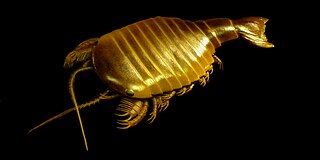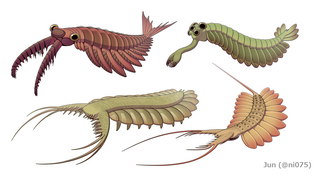Related Research Articles

The Cambrian Period is the first geological period of the Paleozoic Era, and of the Phanerozoic Eon. The Cambrian lasted 53.4 million years from the end of the preceding Ediacaran Period 541 million years ago (mya) to the beginning of the Ordovician Period 485.4 mya. Its subdivisions, and its base, are somewhat in flux. The period was established as "Cambrian series" by Adam Sedgwick, who named it after Cambria, the Latin name for 'Cymru' (Wales), where Britain's Cambrian rocks are best exposed. Sedgwick identified the layer as part of his task, along with Roderick Murchison, to subdivide the large "Transition Series", although the two geologists disagreed for a while on the appropriate categorization. The Cambrian is unique in its unusually high proportion of lagerstätte sedimentary deposits, sites of exceptional preservation where "soft" parts of organisms are preserved as well as their more resistant shells. As a result, our understanding of the Cambrian biology surpasses that of some later periods.

Lobopodians are members of the informal group Lobopodia, or the formally erected phylum Lobopoda Cavalier-Smith (1998). They are panarthropods with stubby legs called lobopods, a term which may also be used as a common name of this group as well. While the definition of lobopodians may differ between literatures, it usually refers to a group of soft-bodied, marine worm-like fossil panarthropods such as Aysheaia and Hallucigenia.

Trilobites are extinct marine arthropods that form the class Trilobita. Trilobites form one of the earliest known groups of arthropods. The first appearance of trilobites in the fossil record defines the base of the Atdabanian stage of the Early Cambrian period and they flourished throughout the lower Paleozoic before slipping into a long decline, when, during the Devonian, all trilobite orders except the Proetida died out. The last extant trilobites finally disappeared in the mass extinction at the end of the Permian about 252 million years ago. Trilobites were among the most successful of all early animals, existing in oceans for almost 270 million years, with over 22,000 species having been described.

Opabinia regalis is an extinct, stem group arthropod found in the Middle Cambrian Burgess Shale Lagerstätte of British Columbia. Opabinia was a soft-bodied animal, measuring up to 7 cm in body length, and its segmented trunk had flaps along the sides and a fan-shaped tail. The head shows unusual features: five eyes, a mouth under the head and facing backwards, and a clawed proboscis that probably passed food to the mouth. Opabinia probably lived on the seafloor, using the proboscis to seek out small, soft food. Fewer than twenty good specimens have been described; 3 specimens of Opabinia are known from the Greater Phyllopod bed, where they constitute less than 0.1% of the community.

Panarthropoda is a proposed animal clade containing the extant phyla Arthropoda, Tardigrada and Onychophora. Panarthropods also include extinct marine legged worms known as lobopodians ("Lobopodia"), a paraphyletic group where the last common ancestor and basal members (stem-group) of each extant panarthropod phylum are thought to have risen. However the term "Lobopodia" is sometimes expanded to include tardigrades and onychophorans as well.

Sidneyia is an extinct arthropod known from fossils found from the Early to the Mid Cambrian of China and the Burgess Shale formation of British Columbia. 144 specimens of Sidneyia are known from the Greater Phyllopod bed, where they comprise 0.27% of the community.

Dinocaridida is a proposed fossil taxon of basal arthropods that flourished in the Cambrian period with occasional Ordovician and Devonian records. Characterized by a pair of frontal appendages and series of body flaps, the name of Dinocaridids comes from Greek, "deinos" and "caris", referring to the suggested role of some of these members as the largest marine predators of their time. Dinocaridids are occasionally referred to as the 'AOPK group' by some literatures, as the group compose of Radiodonta, Opabiniidae, and the "gilled lobopodians" Pambdelurion and Kerygmachela. It is most likely paraphyletic, with Kerygmachela and Pambdelurion more basal than the clade compose of Opabiniidae, Radiodonta and other arthropods.

The Emu Bay Shale is a geological formation in Emu Bay, South Australia, containing a major Konservat-Lagerstätte. It is one of two in the world containing Redlichiidan trilobites. The Emu Bay Shale is dated as Cambrian Series 2, Stage 4, correlated with the upper Botomian Stage of the Lower Cambrian.

Anomalocaris is an extinct genus of radiodont, an order of early-diverging stem-group arthropods.

Aglaspidida is an extinct order of aquatic arthropods that were once regarded as primitive chelicerates. However, anatomical comparisons demonstrate that the aglaspidids cannot be accommodated within the chelicerates, and that they lie instead within the Artiopoda, thus placing them closer to the trilobites. Aglaspidida contains the subgroups Aglaspididae and Tremaglaspididae, which are distinguished by the presence of acute/spinose genal angles and a long spiniform tailspine in the Aglaspididae.
A number of assemblages bear fossil assemblages similar in character to that of the Burgess Shale. While many are also preserved in a similar fashion to the Burgess Shale, the term "Burgess Shale-type fauna" covers assemblages based on taxonomic criteria only.

Arthropods are invertebrate animals in the phylum Arthropoda. They possess an exoskeleton with a cuticle made of chitin, often mineralised with calcium carbonate, a segmented body, and paired jointed appendages. In order to keep growing, they must go through stages of moulting, a process by which they shed their exoskeleton to reveal a new one. They are an extremely diverse group, with up to 10 million species.

Megacheira is an extinct class of predatory arthropods defined by their possession of spined "great appendages". Their taxonomic position is controversial, with studies either considering them stem-group euarthropods, or stem-group chelicerates. The homology of the great appendages to the cephalic appendages of other arthropods is also controversial. Uncontested members of the group were present in marine environments worldwide from the lower to middle Cambrian.

Kunmingella is genus of Cambrian bradoriid from the Chengjiang biota, containing the single species K. douvillei. Kunmingella had 12 appendages, including a pair of antennae as well pairs of biramous limbs, including four anterior pairs of appendages bearing double rows of endites on their endopods, and a posterior 5 with only a single row of endites, as well as two terminal pairs of uniramous limbs. Eggs have been found preserved attached to the posteriormost three pairs of biramous limbs, suggesting it engaged in brood care. Around 50–80 eggs, each around 150–180 μm across were attached in total.

Radiodonta is an extinct order of stem-group arthropods that was successful worldwide during the Cambrian period. They may be referred to as radiodonts, radiodontans, radiodontids, anomalocarids, or anomalocaridids, although the last two originally refer to the family Anomalocarididae, which previously included all species of this order but is now restricted to only a few species. Radiodonts are distinguished by their distinctive frontal appendages, which are morphologically diverse and used for a variety of functions. Radiodonts included the earliest large predators known, but they also included sediment sifters and filter feeders. Some of the most famous species of radiodonts are the Cambrian taxa Anomalocaris canadensis, Hurdia victoria, Peytoia nathorsti, Titanokorys gainessii, Cambroraster falcatus and Amplectobelua symbrachiata, the Ordovician Aegirocassis benmoulai and the Devonian Schinderhannes bartelsi.

Kodymirus is a genus of Early Cambrian arthropod, known from the Czech Republic, which bears some resemblance to eurypterids and aglaspidids. Although it possessed great appendage-like raptorial arms, it was not homologous with those of megacheirans, and was instead a member of Vicissicaudata, closely related to aglaspidids. It is part of a small and low-diversity Paseky Shale fauna group, which dwelt in brackish waters.

Bradoriida, also called bradoriids, are an extinct order of small marine arthropods with a bivalved carapace, which globally distributed, forming a significant portion of the Cambrian and Early Ordovician soft-bodied communities.

Diania is an extinct genus of lobopodian panarthropod found in the Lower Cambrian Maotianshan shale of China, represented by a single species - D. cactiformis. Known during its investigation by the nickname "walking cactus", this organism belongs to a group known as the armoured lobopodians, and has a simple worm-like body with robust, spiny legs. Initially, the legs were thought to have a jointed exoskeleton and Diania was suggested to be evolutionarily close to early arthropods, but many later studies have rejected this interpretation.

The Artiopoda is a grouping of extinct arthropods that includes trilobites and their close relatives. It was erected by Hou and Bergström in 1997 to encompass a wide diversity of arthropods that would traditionally have been assigned to the Trilobitomorpha. Trilobites, in part due to their mineralising exoskeletons, are by far the most diverse and long lived members of the clade, with most records of other members, which lack mineralised exoskeletons, being from Cambrian deposits.

Hymenocarina is an order of extinct arthropods known from the Cambrian. They possess bivalved carapaces, typically with exposed posteriors. Members of the group are morphologically diverse and had a variety of ecologies, including as filter feeders and as predators. Recent research has generally considered them to be stem or crown group members of Mandibulata, due the presence of mandibles in at least some species.
References
- ↑ Hou, X.; Bergström, J. (1997), Arthropods of the Lower Cambrian Chengjiang fauna, southwest China (PDF), Fossils & Strata, Scandinavian University Press, pp. 1–116, ISSN 2637-6032
- ↑ Stein, Martin (November 2013). "Cephalic and appendage morphology of the Cambrian arthropod Sidneyia inexpectans". Zoologischer Anzeiger - A Journal of Comparative Zoology. 253 (2): 164–178. doi:10.1016/j.jcz.2013.05.001.